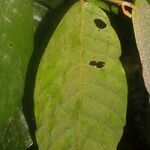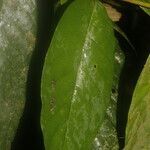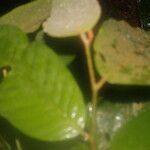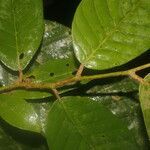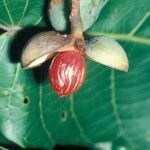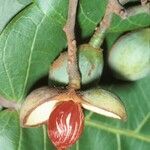Dioecious, often buttressed trees to 40 m., the younger branchlets persistently tomentose or glabrescent. Leaf blades glabrous above, with persistent, ochraceous stalked-stellate hairs below, coriaceous, oblong to elliptic-ovate or obovate, acute to acuminate, cordate, truncate or acute, 10-47 cm. long, 4-15 cm. broad; secondary veins 10-28 per side, averaging less than 1 per cm. along the midrib, the tertiary veins rather prominent below; petioles canaliculate, 8-25 mm. long, 2-5 mm. broad. Staminate flowers in much-branched panicles; pedicels 0-3 mm. long; bracts inconspicuous or absent; perianth tardily 3(-5)-lobed, 1.3-3.0 mm. long; anthers 3(-5), 0.7-1.5 mm. long, usually connate to the apex, the infra-antheral portion of the androecium 0.2-1.0 mm. long. Pistillate flowers solitary or clustered in racemes 3-7 cm. long, 2-7 cm. broad; pedicels 1-4 mm. long; tepals partially connate, with subpinnate ochraceous pubescence; ovary 1-carpellate, with a sessile, obscurely 2-lobed stigma. Fruits 10-30 per inflorescence, the velutinous ligneous pericarp ultimately dehiscing longitudinally into 2 valves, subglobose to ellipsoid, 10-21 mm. long, 7-17 mm. broad; seed ellipsoid to subglobose, the aril laciniate.
More
A medium sized tree. It grows 20 m tall. The branches are arranged in rings. The twigs have red hairs. The leaves are alternate and are regularly spaced. The leaves underneath are bluish green with red veins. Broken pieces produce sap that turns red. The flowers are in groups in the axils of leaves or at the ends of branches. The fruit is a capsule 1.5 cm long by 1 cm wide. It has a rusty covering.
Found mainly in savannah and semideciduous forests at higher elevations, almost always on well-drained soils. It is not frequent in dense, primary forests. Grows principally in secondary forests. Found from sea level to 1,500 metres.
More
A tropical plant. It grows in the rainforest, often on sandy soils.
